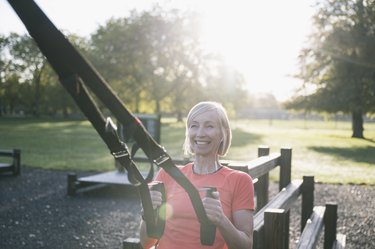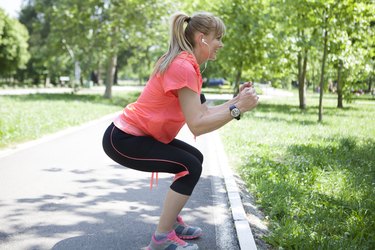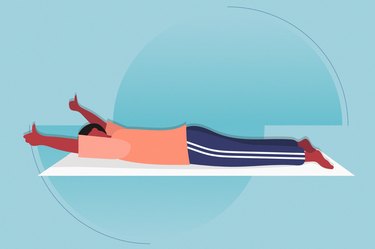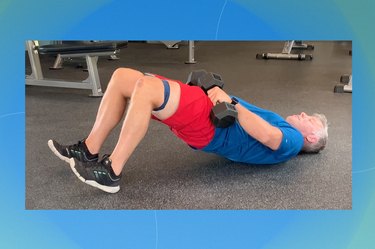
Whether you're opening doors or lifting trash bags, pulling is something you do every day. Still, training your body to pull efficiently and with strength can help you continue to move comfortably (and however else you want!) as you age.
That's why it's important to incorporate a lot of pulling exercises, which target the backside of your body, into your workout routine, says Damien A. Joyner, CPT, a certified personal trainer who specializes in health aging, and owner of Incremental Fitness.
Video of the Day
"Exercises that take pulling a step further by engaging the entire posterior chain not only strengthen the body but teach us the proper way to pick things up," Joyner says. "Practicing any variation of pulling weight off the ground is important to facilitate strength and stability and help reduce the risk of a lower-back injury."
Pulling exercises can also help improve poor posture, he says. When you're sitting all day, for instance, you're usually hunched forward (perhaps over a computer, phone or book). This causes your chest muscles to contract and shorten while your upper-back muscles lengthen and lose some strength.
But by working the backside of your body, you can even things out. Many trainers recommend that, for balance, you do two pulling exercises for every single pushing movement (like chest press variations and push-ups) you do.
For a well-balanced fitness routine, include at least one pulling exercise in every strength workout you do. Below, Joyner breaks down five of the best pulling exercises for strong decades ahead. Ideally, each week, you'd hit them all.
The 5 Best Pulling Exercises for Healthy Aging
Move 1: Bent-Over Row
- Stand just behind the bar with your feet hip-width apart. Hinge your torso forward, push your butt back and soften your knees so that you can grab onto the barbell with an overhand (palms down) grip.
- Brace your core and think about keeping your back completely flat as you lift the bar off the ground. Your torso should be as close to horizontal as you can get it without rounding it or jerking as you lift. Keeping your hips as far back as possible will eliminate any stress in your lower back.
- Row the bar up toward your upper waist, bending your elbows as you do so that they move behind your torso. Squeeze your shoulder blades together and pause at the top of the movement.
- Keep your core and spine stable as you extend your arms and lower the bar so that it hangs by your shins.
For this exercise, people of all ages get the go-ahead to use a barbell. (Most weigh 45 pounds, and short preloaded ones can weigh even less.) But if you don’t have a barbell or don’t feel comfortable using one, you can swap in dumbbells. Because dumbbells move independently of one another, rowing them can also help improve shoulder stability and strength, Joyner says.
This exercise targets the arms, back, shoulders and forearms. Your hamstrings will also get a little work in the hinge position, he says.
Move 2: Seated Band Row
- Sit on the floor with your legs extended in front of you. Wrap a resistance band around the bottoms of your feet and hold onto each end of the band with your arms extended.
- Keeping your spine straight and core braced, pull each end of the band toward your torso and bend your elbows, stopping when they go just past your back. Squeeze your shoulder blades together.
- Pause briefly before reversing the movement to bring the band back to the starting position.
“Because of the position and engagement of your core, it can help to encourage better standing and sitting posture,” Joyner says.
To keep the band nice and secure (and prevent getting whipped in the face), try wrapping the band around your feet in a "figure 8" shape.
Move 3: Single-Arm Cable Row in Split Stance
- Stand facing a cable machine and hold the handle in your right hand at lower-chest height. Take a step back with your right leg to get into a split stance. Your arm should be straight.
- Brace your core and keep your hips level as you pull the cable toward your body without allowing your body to move or rotate. Pull until your elbow moves just past your torso.
- Slowly reverse the movement and straighten your arm again.
- Do all your reps before switching arms and legs.
This standing cable row variation is a unilateral exercise that primarily targets the back but still gets the whole body involved. The split stance also encourages core and hip stabilization, Joyner says. “The stance can force people to move with more control. "They have to keep their lower half quiet and stable while the pulling happens.”
If you don't have access to a cable machine, you can secure a resistance band to a sturdy anchor like a pole.
Move 4: Suspension Row
- Stand facing a TRX or other suspension trainer. Grab onto both handles and take a few steps forward so that your feet are a bit underneath the straps.
- Brace your core and lean your entire body back a few inches, moving onto your heels so that your arms are completely straight. Your palms should be facing each other.
- Pull your body up toward the handles, bending your elbows until handles come close to the sides of your chest.
- Pause for a moment, and then straighten your arms to reverse the motion.
This exercise targets your arms, back, shoulders and core. “It is essentially a standing plank,” Joyner says. “A controlled row with palms facing each other while holding a tall standing plank can make this a good exercise to help facilitate better posture.”
Move 5: Single-Leg Cable Deadlift to Balance
- Stand facing a cable machine and hold the handle in your right hand at lower-chest height. Take a step back with your right leg to get into a split stance. Your right arm should be straight with tension in the cable. Extend your left arm out to the side as a counterbalance.
- Lift your right leg off the floor as you hinge your torso forward and push your butt back. Bend your left leg.
- Stand up straight and lift your right knee toward your chest as you pull the cable toward your body until your elbow moves just past your torso.
- Pause for a moment, and then slowly straighten your arm as you hinge forward at your hips, bringing your right leg back out behind you and bending your left leg.
- Do all your reps before switching arms and legs.
In addition to working your arms, back, shoulders and hamstrings, “this complex movement calls for coordination, control and balance,” Joyner says. Because of this, you’ll likely need to use less weight than you did with the bent-over row to make sure you can execute the movement with control and good form, he says.



